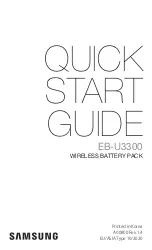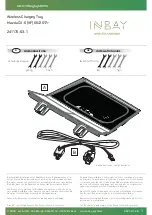
4
5
SAFETY GUIDELINES /
DEFINITIONS
DANGER:
Indicates an imminently hazardous situation which, if not
avoided, will result in death or serious injury.
WARNING:
Indicates a potentially hazardous situation which, if not
avoided, could result in death or serious injury.
CAUTION:
Indicates a potentially hazardous situation which, if not
avoided, may result in minor or moderate injury.
CAUTION:
Used without the safety alert symbol indicates potentially
hazardous situation which, if not avoided, may result in property damage.
RISK OF UNSAFE OPERATION.
When using tools or equipment,
basic safety precautions should always be followed to reduce the risk of
personal injury. Improper operation, maintenance or modification of tools
or equipment could result in serious injury and property damage. There
are certain applications for which tools and equipment are designed.
Manufacturer strongly recommends that this product NOT be modified and/
or used for any application other than for which it was designed. Read and
understand all warnings and operating instructions before using any tool
or equipment.
READ ALL
INSTRUCTIONS
WARNING:
Read all instructions before operating the battery
charger. Failure to follow all instructions listed below may result in
electric shock, fire and/or serious injury.
IMPORTANT SAFETY
INSTRUCTIONS
GENERAL SAFETY WARNINGS AND
INSTRUCTIONS
• The unit was designed for household use only.
WARNING –
To reduce the risk of fire, electric shock, burst
hazard, or injury to persons or property:
•
Avoid dangerous environments.
Don’t use the battery charger in damp
or wet locations. Do not expose the battery charger to rain or snow.
•
Keep children away.
Keep away from children. This is not a toy!
•
Store indoors.
When not in use, battery chargers should be stored
indoors in dry, and high or locked-up places – out of reach of children.
•
Unplug the battery charger
when not in use.
•
Check for damaged parts.
Any part that is damaged should be
properly repaired or replaced by manufacturer unless otherwise indicated
elsewhere in this instruction manual before further use.
SPECIFIC SAFETY INSTRUCTIONS FOR
POWER CORDS
•
Don’t abuse cord.
Never carry appliance by cord or yank it to disconnect
from receptacle. Keep cord from heat, oil, and sharp edges. Pull by plug
rather than cord when unplugging the unit.
•
Ground fault circuit interrupter
(GFCI)
protection should be provided on
the circuits or outlets to be used. Receptacles are available having built in
GFCI protection and may be used for this measure of safety.
DANGER –
Never alter AC cord or plug provided
– if it will not fit
the outlet, have a proper outlet installed by a qualified electrician. Improper
connection can result in a risk of an electric shock.
Extension Cords
•
An extension cord should not be used unless absolutely necessary.
Use of an improper extension cord could result in a risk of fire and electric
shock, and will void warranty.
•
If an extension cord must be used,
make sure your extension cord is in
good condition. When using an extension cord, be sure to use one heavy
enough to carry the current your product will draw. An undersized cord
will cause a drop in line voltage resulting in loss of power and overheating.
The following table shows the correct size to use depending on cord
length and nameplate ampere rating. If in doubt, use the next heavier
gauge. The smaller the gauge number, the heavier the cord.
Recommended Minimum AWG Size for Extension Cords for Battery Chargers
AC Input Rating
American Wire Gauge (AWG) Size of Cord
Amperes
Length of Cord, feet (m)
Equal to or But less
25 (7.6)
50 (15.2)
100 (30.5)
150 (45.6)
greater than
than
0
2
18
18
18
16
2
3
18
18
16
14
3
4
18
18
16
14
4
5
18
18
14
12
5
6
18
16
14
12
6
8
18
16
12
10
8 10 18 14 12 10
10 12 16 14 10
8
12 14 16 12 10
8
14 16 16 12 10
8
16
18
14
12
8
8
18
20
14
12
8
6
Power Cord Safety
The unit has a polarized plug (one blade is wider than the other) as a
safety feature. This plug will fit into a polarized outlet only one way. If the
plug does not fit fully into the outlet, reverse the plug. If it still does not fit,
contact a qualified electrician. Do not attempt to defeat this safety feature.
SPECIFIC SAFETY INSTRUCTIONS FOR
BATTERY CHARGERS
WARNING –
Burst Hazard:
Do not use the unit for charging dry-cell
batteries that are commonly used with home appliances. These batteries
may burst and cause injury to persons and damage property. Use the unit
for charging/boosting a 12 volt battery only. It is not intended to supply
power to a low-voltage electrical system other than in a starter-motor
application.
•
Use of accessories and attachments:
the use of any accessory or
attachment not recommended by manufacturer for use with this battery
charger could be hazardous.
•
Stay alert.
Use common sense. Do not operate this equipment when you
are tired or impaired.
•
Do not operate
the battery charger near flammable liquids or in gaseous
or explosive atmospheres. Motors may spark, and the sparks might ignite
fumes.
•
Do not operate the battery charger
if it has received a sharp blow, been
dropped, or has been otherwise damaged in any way. Return it to the
manufacturer for repair.
WARNING –
To reduce the risk of electric shock:
• Never immerse the battery charger in water or any other liquid, or use
when wet.
WARNING –
Risk of explosive gases:
• WORKING IN THE VICINITY OF A LEAD ACID BATTERY IS DANGEROUS.
BATTERIES GENERATE EXPLOSIVE GASES DURING NORMAL BATTERY
OPERATION. FOR THIS REASON, IT IS OF THE UTMOST IMPORTANCE
THAT EACH TIME BEFORE USING THE BATTERY CHARGER YOU READ
THIS MANUAL AND FOLLOW INSTRUCTIONS EXACTLY.
• To reduce the risk of battery explosion, follow these instructions and those
published by the battery manufacturer and manufacturer of any equipment
you intend to use in the vicinity of the battery. Review cautionary markings
on these products and on the engine.
• This equipment employs parts (switches, relays, etc.) that produce arcs or
sparks. Therefore, if used in a garage or enclosed area, the unit MUST be
placed not less than 18 inches above the floor.
• THIS UNIT IS NOT FOR USE BY CHILDREN AND SHOULD ONLY BE
OPERATED BY ADULTS.
WARNING –
To reduce the risk of fire:
• Do not operate near flammable materials, fumes or gases.
• Do not expose to extreme heat or flames.
CAUTION –
To reduce the risk of injury or property damage:
• NEVER ATTEMPT TO CHARGE A FROZEN BATTERY.
• Do not charge the battery while the engine is operating.
• Stay clear of fan blades, belts, pulleys, and other parts that can cause
injury to persons.
• Vehicles that have on-board computerized systems may be damaged if
vehicle battery is jump-started. Before jump-starting, read the vehicle’s
owner’s manual to confirm that external-starting assistance is suitable.
• When working with lead acid batteries, always make sure someone is
close enough to provide immediate assistance in case of accident or
emergency.
• Always have protective eyewear when using this product: contact with
battery acid may cause blindness and/or severe burns. Be aware of first
aid procedures in case of accidental contact with battery acid.
• Have plenty of fresh water and soap nearby in case battery acid contacts
skin.
• If battery acid contacts skin or clothing, wash immediately with soap and
water for at least 10 minutes and get medical attention immediately.
• Never smoke or allow a spark or flame in vicinity of vehicle battery, engine
or battery charger.
• Remove personal metal items such as rings, bracelets, necklaces and
watches when working with a lead acid battery. A lead acid battery can
produce a short circuit current high enough to weld a ring, or similar metal
object, to skin causing a severe burn.
• Be extra cautious to avoid dropping a metal tool onto the battery. It might
spark or short-circuit the battery or another electrical part, and that may
cause an explosion.
• Never allow battery acid to come in contact with this unit.
• Do not operate this unit in a closed area or restrict ventilation in any way.
• Always turn the battery charger off by unplugging it when not in use.
• Do not open the BATTERY CHARGER — there are no user-serviceable
parts inside. Opening the battery charger will void the manufacturer’s
warranty.
• Operate battery charger only as described in this Instruction Manual.
• Check battery charger and components periodically for wear and tear. Do
not disassemble the unit. Return to manufacturer for replacement of worn
or defective parts immediately.
FIRST AID
•
Skin:
If battery acid comes in contact with skin, rinse immediately with
water, then wash thoroughly with soap and water. If redness, pain, or
irritation occurs, seek immediate medical attention.
•
Eyes:
If battery acid comes in contact with eyes, flush eyes immediately,
for a minimum of 15 minutes and seek immediate medical attention.
•
LCD liquid crystal display:
If liquid crystal comes in contact with your
skin: Wash area off completely with plenty of water. Remove contaminated
clothing. If liquid crystal gets into your eye: Flush the affected eye with
clean water and then seek medical attention. If liquid crystal is swallowed:
Flush your mouth thoroughly with water. Drink large quantities of water
and induce vomiting. Then seek medical attention.
WARNING –
To reduce the risk of injury:
Follow these instructions
and those published by the battery manufacturer and manufacturer of any
equipment you intend to use with this unit. Review cautionary markings on
this product and on engine.
SAVE THESE
INSTRUCTIONS
INTRODUCTION
Congratulations on purchasing your
Vector™
battery charger
.
Read this
Instruction Manual and follow the instructions carefully before using
your new battery charger.
PREPARING TO CHARGE
1. Be sure area around battery is well ventilated while battery is being
charged.
2. Remove battery completely from boat/airplane or any confined area
before charging.
3. If it is necessary to remove battery from vehicle to charge, or to clean
terminals, always remove grounded terminal from battery first. Make
sure all accessories in the vehicle are off, so as not to cause an arc.
4. Clean battery terminals, taking care to avoid getting corrosive material
in eyes.
5. Add distilled water in each cell until battery acid reaches level specified
by battery manufacturer. This helps purge excessive gas from cells. Do
not overfill. For a battery without cell caps (maintenance free), carefully
follow manufacturer’s charging instructions.
6. Study all battery manufacturer’s specific precautions, such as removing
or not removing cell caps while charging, and recommended rates of
charge.
7. Determine voltage of battery to be charged by referring to the vehicle
manual. The unit is for charging a 12 volt battery only.
Charger Location
• Locate charger as far away from battery as cables permit.
• Never place charger directly above battery being charged; gases from
battery will corrode and damage charger.
• Never allow battery acid to drip on charger when reading gravity or filling
battery.
• Never operate charger in a closed-in area or restrict ventilation in any way.
• A marine (boat) battery must be removed and charged on shore. To
charge it on board requires equipment specifically designed for marine
use. This unit is NOT designed for such use.
• Do not set a battery on top of charger.
Connection Precautions
• Never allow clamps to touch each other.
• Attach clamps to battery and chassis as indicated in “Battery Installed in
Vehicle” steps 5 and 6, or in “Battery Outside of Vehicle” steps 2 to 5.
Charging a battery installed in a vehicle
WARNING –
A spark near the battery may cause an explosion.
To reduce risk of a spark near the battery:
1. Position AC and clamp cords to reduce risk of damage by hood, door,
or moving engine part.
2. Stay clear of fan blades, belts, pulleys, and other parts that can cause
injury to persons.
3. Check polarity of battery posts. POSITIVE (POS, P, +) battery post
usually has larger diameter than NEGATIVE (NEG, N, –) post.
4. Determine which post of battery is grounded (connected) to the
chassis. If negative post is grounded to chassis (as in most vehicles),
see 5. If positive post is grounded to the chassis, see 6.
5. For negative-grounded vehicle, connect POSITIVE (RED) clamp from
battery charger to POSITIVE (POS, P, +) ungrounded post of battery.
Connect NEGATIVE (BLACK) clamp to vehicle chassis or engine block
away from battery. Do not connect clip to carburetor, fuel lines, or
sheet-metal body parts. Connect to heavy gauge metal part of the
frame or engine block.
6. For positive-grounded vehicle, connect NEGATIVE (BLACK) clamp
from battery charger to NEGATIVE (NEG, N, –) ungrounded post of
battery. Connect POSITIVE (RED) clamp to vehicle chassis or engine
block away from battery. Do not connect clip to carburetor, fuel lines
or sheet-metal body parts. Connect to a heavy gauge metal part of the
frame or engine block.
7. When disconnecting charger, disconnect AC cord, remove clamp from
vehicle chassis, and then remove clamp from battery terminal.
8. Do not charge the battery while the engine is operating.
9. See operating instructions for length of charge information.
Charging a battery that has been removed from a
vehicle
WARNING –
A spark near the battery may cause an explosion.
To reduce risk of a spark near the battery:
1. Check polarity of battery posts. The Positive post (marked POS, P, +)
usually has a larger diameter than the Negative battery post (marked
NEG, N, –).
2. Attach a 24-inch (minimum length) AWG #6 insulated battery cable to
the Negative battery post (marked NEG, N, –).
3. Connect the Positive (RED) battery clamp to the Positive battery post
(marked POS, P, + or red).
BC15BV_ManualENSP_040220.indd 4-5
BC15BV_ManualENSP_040220.indd 4-5
4/6/2020 7:02:30 PM
4/6/2020 7:02:30 PM



























